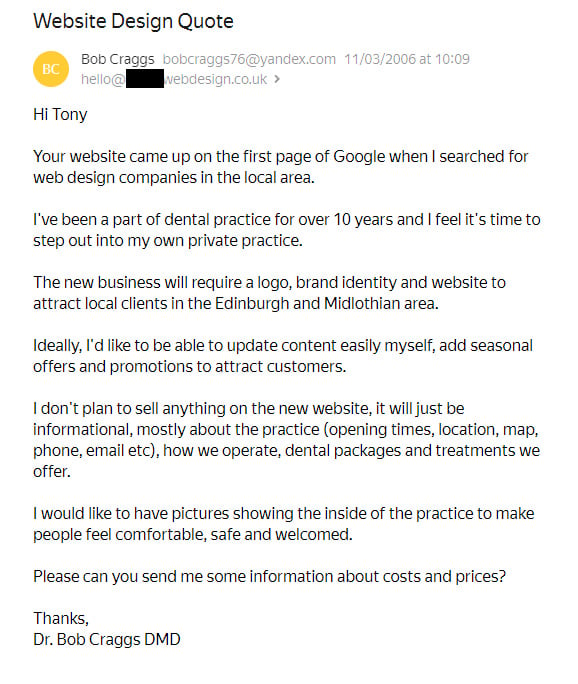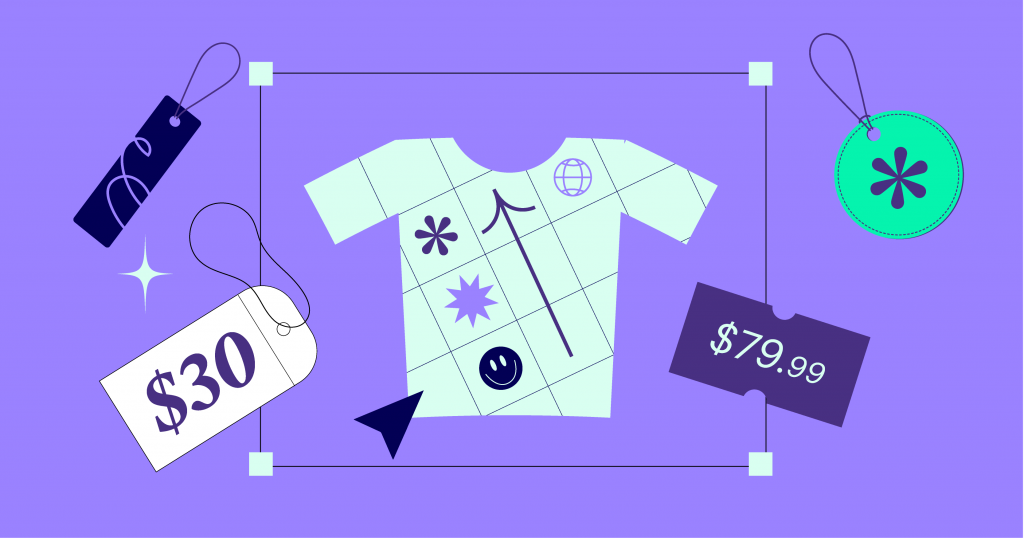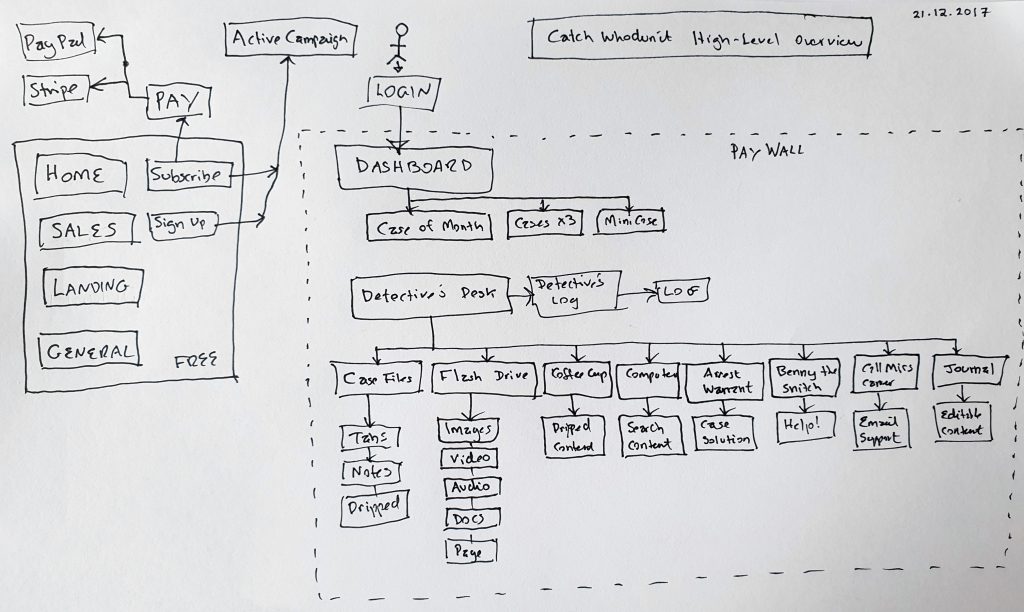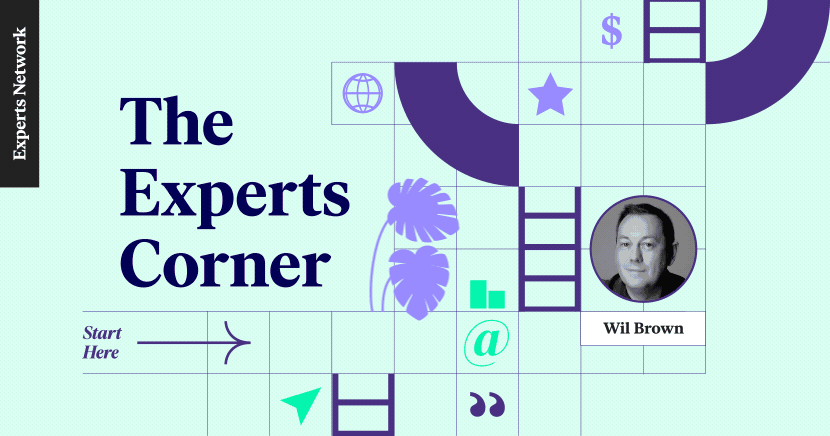The year was 2009, and I’d been freelancing for just over three years, working part-time to support my growing website development side-gig business, living in Scotland. My website business had grown steadily, and so had my skills and experience.
As most developers do, I had created my own simple content management system (CMS) where clients could log in and create their web page content, however, I struggled to keep up with the feature demands from clients and soon was on the lookout for an “off-the-shelf” application.
I reviewed several CMS’s available at the time: Drupal, Joomla, WordPress, Silverstripe, ExpressionEngine, Magento, and Django. I ended up choosing Joomla as my go-to CMS and WordPress for a few smaller sites.
My clients were mainly local solo businesses, gardeners, painters, electricians, plumbers, personal trainers, artists, photographers, and the like. I found most of my early clients through friends and family or by word-of-mouth from completed projects.
It soon became clear that the current version of Joomla had some severe user interface (UI) and user experience (UX) issues which made training very difficult.
Towards the end of my third year, my biggest client was a publishing company that wanted three websites to complement their monthly glossy publications. It took me longer to train the staff how to use Joomla than it took me to create the three websites in the first place!
At the same time, the clients to whom I delivered a WordPress website seemed to create and update their website intuitively with minimal training. I dropped Joomla and decided to use WordPress for future projects exclusively.
During the first three years, I raised my prices accordingly, starting at $500, then $750, $999, $1,200, and finally $2,500 in 2009.
My price increases were in line with my competitors and based on my time to create a customer’s website. However, over the next couple of years, I struggled to get customer acceptance on projects I priced over $3,000.
Website feature requests were increasing, as was integration with social media sites. I stepped into the ecommerce world, creating simple online shops with the WordPress plugins that existed before WooCommerce.
I was spending longer creating websites, so I wanted to increase my pricing accordingly to reflect that. However, my $3k+ proposals were being rejected.
There seemed to be a $3k project ceiling that I could not break through, but I knew others were charging $10k+ and I was determined to find out how.

Stuck In A Pricing Rut!
When I first started out creating websites for customers, I didn’t give much thought to pricing. Of course, I wanted to make a profit. After all, a business that doesn’t make money is just an expensive hobby.
I had already decided I didn’t want to position myself at the bottom of the market nor charge a premium and price myself out of the industry.
The cheeky “fake” quotes I had sent my competitors from a temporary Hotmail account had confirmed their pricing strategy was based on how long it would take them to create a website for their customers. I received quotes for websites with 5, 10, or 10+ pages, priced accordingly higher the more required pages.
This pricing strategy is “called cost-based pricing”, or “cost-plus pricing”, not that I knew what that meant back then. Still, the pricing strategy was familiar to me and others, such as accountants, lawyers, and similar professionals.
For the websites I was creating, cost-based pricing was working very well. As websites became more complicated, I increased my prices towards $2k, thinking that the price-point justified my increased development effort.
However, as I would soon find out, you can only stretch cost-based pricing so far.
My average project completion time was six weeks from project conception to delivery, and this time had pretty much stayed constant from when I had started creating websites for clients. The website requirements were getting more complicated, but I became faster and more adept at making them with WordPress.
My most significant accepted project price at that time was $2,500 for a 6-week project, so for a 37-hour working week, the project worked out about $11 per hour, which, if the client were hiring me at that price-point, would work out to be an annual salary of $21k.
The client was a legal professional and was pretty desperate to get a website launched in time for an expensive TV and radio ad campaign they had already paid. They had already been burned by their current developer, who had disappeared.
For the client, my price was affordable because I had convinced them I could deliver what they needed when they needed it, and that was a good return of investment (ROI) for my client, given their current situation.
Grow Your Sales
- Incredibly Fast Store
- Sales Optimization
- Enterprise-Grade Security
- 24/7 Expert Service

- Incredibly Fast Store
- Sales Optimization
- Enterprise-Grade Security
- 24/7 Expert Service
- Prompt your Code & Add Custom Code, HTML, or CSS with ease
- Generate or edit with AI for Tailored Images
- Use Copilot for predictive stylized container layouts

- Prompt your Code & Add Custom Code, HTML, or CSS with ease
- Generate or edit with AI for Tailored Images
- Use Copilot for predictive stylized container layouts
- Craft or Translate Content at Lightning Speed
Top-Performing Website
- Super-Fast Websites
- Enterprise-Grade Security
- Any Site, Every Business
- 24/7 Expert Service

Top-Performing Website
- Super-Fast Websites
- Enterprise-Grade Security
- Any Site, Every Business
- 24/7 Expert Service
- Drag & Drop Website Builder, No Code Required
- Over 100 Widgets, for Every Purpose
- Professional Design Features for Pixel Perfect Design

- Drag & Drop Website Builder, No Code Required
- Over 100 Widgets, for Every Purpose
- Professional Design Features for Pixel Perfect Design
- Marketing & eCommerce Features to Increase Conversion
- Ensure Reliable Email Delivery for Your Website
- Simple Setup, No SMTP Configuration Needed
- Centralized Email Insights for Better Tracking

- Ensure Reliable Email Delivery for Your Website
- Simple Setup, No SMTP Configuration Needed
- Centralized Email Insights for Better Tracking

- Ensure Reliable Email Delivery for Your Website
- Simple Setup, No SMTP Configuration Needed
- Centralized Email Insights for Better Tracking
The Problem With Cost-based Pricing
When I started pitching $3k+ proposals for other clients, I immediately started to get knocked back. Those clients were doing the same math, but their situation was different. They had no urgency; therefore, their perceived ROI was lower.
A $3k project over six weeks costs $14 per hour or an annual salary of $27,000. In 2009, that salary was comparable with a mid-level software engineer. Bump the project price up to $5k, and your annual salary works out to be around $43k, more than a senior-level software engineer would expect to make in the UK at that time.
Cost-based pricing does not scale because the only metric the client can measure ROI is on your time.
The Classic Freelancer Pricing Strategy
Most freelancers set an expectation of revenue each year, based on the cost of living and the lifestyle they would like to live.
Let’s set a revenue expectation of $100,000.
Consider a situation where you have two clients who want an e-commerce website with comparable complexity and features. Both clients currently sell their products in brick-and-mortar stores and want to grab a slice of the online market.
Client A is a startup company with an angel investor and has been selling products in their single store for three months with monthly sales of $10,000. Client B is a well-known brand and has sold products in their stores for over ten years with monthly sales of $300,000.
With cost-based pricing, you will be charging by the hour based on how long it will take you to develop an e-commerce website. As the requirements from both clients are pretty much the same, you price them similarly:
- Client A gets a proposal for 40 hours at $100/hour = $4,000
- Client B gets a proposal for 40 hours at $100/hour = $4,000
Both clients have a proposal with the exact cost of $4,000.
You only have the time to build two ecommerce websites per month, and you are strapped for cash, so you need that $8,000 monthly revenue. Assuming you can close these deals and get another two ecommerce projects every month for the next year, your revenue will be $96,000, which is pretty close to your goal.
So you are working a minimum of 80 hours per month, all year to achieve your revenue goal, and we all know that projects pretty much always go over time.
Let’s flip viewpoints to those two clients who accepted your proposal of $4,000.
Client A generates $40,000 in yearly online sales. They had a lousy year, and their product wasn’t as popular online as they had expected. However, they made an x10 ROI on your work, and if they sort out their marketing, this will increase after that.
Client B generates $720,000 in yearly online sales. Online sales were initially slow to pick up, but momentum increased towards the end of the year. They made an x180 ROI on your work and continue to do so every year after that.
Being a startup without a proven track record, client A had a reasonably high risk of failure in the online marketplace. Client B was heavily weighted to be successful online given their great history with brick and mortar.
If you had done your research and proposed just to client B with a value-based proposal, they would quickly have paid $100,000 or $50,000 for the project, given their high chance of making a great ROI.
Your worth is based on the value you can bring to a client, not on the cost of your time and effort.
The “Ah-Ha” Moment
Do you remember those “fake” quotes I had sent out to competitors?
In those quotes, I had positioned myself as a private dental practice looking to rebrand and attract more clients in the local area.

One of the proposals I received from a competitor was priced at $12,750. I had immediately discarded the quote as ludicrously high and way overpriced.
That person was laughing at my expense! I was sure they had figured out that my quote was fake, and they were throwing me a curveball to teach me a lesson.
I decided to dig the proposal out from my archives to see if there was anything different in there — I keep everything — I’m an email hoarder! To my surprise, it was a rather lengthy, detailed, and professional proposal. I had dismissed it outright based on the price.
In the proposal, the competitor had correctly identified that I was a private dental practice. They had included average costs that a private customer would pay for general dental surgery in my local area (customer value) and the number of additional times the customer would revisit the same practice for extra dental work (lifetime customer value).
They surmised that if the new website they developed could generate 20 new leads per month and I converted 25% of them to paying customers, that would generate $X amount of revenue per year for the dental practice business.
Their project price point of $12,750 was 10% of the total yearly revenue they said the new website could generate. It made total sense, and if this were an actual project proposal, I’d have been on the phone asking them when they could start!
This was an “Ah-Ha!” moment for me.
How Value-Based Pricing Works
Value-based price is a pricing strategy that sets your price according to the customer’s perceived value of your product or service. If you’re used to working with cost-based pricing, then value-based pricing can take a bit of learning.
To consumers/customers/clients, price is a numerical evaluation of how much they value what you are selling. For example, if I needed a shirt, I could grab a second-hand one from my local Salvation Army store for three dollars or buy one from GAP at $80. If I only cared about covering my chest, I would get the one at the Salvation Army. However, I may also care about fashion, comfort, and quality, so GAP gets my business.
Perceived value is the key to making this pricing strategy work when putting a price tag on client projects. To calculate the value of a web design project, you need to obtain some information about the client’s business, particularly their lead, customer, and sales information.
A basic example of value-based pricing is determining the client’s customer value is $1,000 and customer lifetime value is $10,000. They have an average 20% conversion rate from a lead to a paying client. Based on the current website traffic and traffic to their top 10 pages, you determine that your newly designed website can produce 50 new leads every month.
If the client can convert 20% of the leads to 10 paying clients every month, that’s a possible $120,000 of sales in the first year and an overall possible $1,200,000 of lifetime value sales, just from those first-year clients.
In this example, you can base your price on a percentage of the possible potential value to the client over the year; 10% of $120,000 is $12,000. You can be bolder and base your project price on the median lifetime value from that first year; 10% of $1,200,000, which is $120,000.
Because you are working with metrics that the business owner has provided, it’s evident for them to see the return of investment. In this case, if you presented your project proposal at a $120,000 investment with a possible return of $1.2 million of lifetime sales just from the customers gained in the first year, it’s a bit of a no-brainer decision.
Sure, clients may still haggle with the price point. That’s a pretty standard business practice, but the metrics are on your side, and the price bracket is still within an order of magnitude larger than you will be used to charging in the past.
Rather than negotiate on price for the same proposal, try cutting back on features.

How I Smashed Through $3K Price Ceiling
To use value-based pricing in your freelancing business today, you need to ensure you work with clients with a decent budget to spend. This question means qualifying leads through your website, avoiding setting up meetings with everyone who contacts you. That’s a waste of your valuable time.
You should already have at least one ideal client avatar and are producing solution-based content and offers that address their general pain points, pushing them down your sales funnel to a point where they are happy to reach out and contact you.
Qualifying Leads
When you are approached for a piece of work, if the lead hasn’t done so already, ask them to fill out your project proposal form on your website.
The project proposal form should ask for metrics like budget, average monthly website traffic, bounce rate, most important goal and ideal customer description, and the regular information you need to capture to contact them.

Avoid asking customer, turnover, sales, or profit-based questions in your project proposal form as those data are too sensitive to enter into a faceless form. I’ve tried this, and it doesn’t work.
Your website project proposal form just needs to ensure that the client has a committed budget, good website traffic, and engagement to generate leads from.
Once you have qualified a lead through your website, it’s time to set up a “Discovery Session” meeting with them.
Running a Client Discovery Session
A client discovery session aims to ask questions about their business, clients, products, and services to have the metrics needed to put together a value-based price for the project proposal.
The outcome of a client discovery session is to gather the metrics you need to put together a value-based proposal and to learn about any additional issues or problems that weren’t first evident.
A client discovery session needs to be done in person or via a video call because you need to “read” the client’s body language when you ask them questions — you can’t do that over the phone or via email.

During a discovery session, I often notice the client may be uncomfortable or struggling to answer a question which leads to a conversation revealing additional pain points, problems, and issues that weren’t mentioned in the initial contact.
Own the Session and Lead the Conversation
Have a plan ready for the meeting and make sure that you lead the conversation. This session needs to be laser-focused, and if the conversation starts to derail, use the plan to swing it back on track.
Ask lots of business and operational questions to make sure you get all the metrics you need to cost the project effectively and follow up every question with “Why is this important to you?”, this is called “digging wide and deep”.
Your key metrics are:
- Most profitable products or services
- Customer Value (CV)
- Customer Lifetime Value (CLV)
- The monthly website user traffic and bounce rates
- Lead conversion rate
- Cost per lead (Ad rates)
- Target market
- Ideal customer avatars
- Top 20 visited website pages (excluding home page)
- Existing landing page conversion rates
- Top-performing SEO keywords
Dealing With Client Pushback on Questions
Some clients will not be used to a constant barrage of “why” questions about their business and may become defensive about giving answers.
That’s pretty normal at this stage, and I guarantee most clients haven’t sat down and considered why they need a website or a website redesign from a pure return of investment (ROI) basis.
They may also misunderstand concepts about digital marketing or ecommerce that you deal with daily as a web expert.
If you get pushback on any questions due to confidentiality, then you can offer to sign a non-disclosure agreement (NDA). If you get pushback on any general business operations questions, you can use the analogy of a doctor diagnosing a patient before assigning the appropriate treatment.
“If you have a sore head, you may ask a doctor for headache tablets. However, after diagnosing the problem, a doctor may discover that your headaches are due to back muscle tension, which requires a whole different course of treatment than the one you originally thought you needed.”
Concluding Questions
When wrapping up the client discovery session, remember to ask these two questions.
“Is there anything else in your business that is causing issues right now?”
This question has worked out for me very well over the years and may offer you some value-add benefits to include in your solution.
A client once told me they dreaded the end of the month because it took them hours to export sales data from WooCommerce into spreadsheets to feed their inventory software.
They weren’t aware of Zapier and automation. I included this in the proposal, saving them approximately 12 hours every month, which won me that particular proposal.
“If I delivered the perfect solution, what would that be, and how would your business look afterwards?”
This question gives future insights into the client’s long-term insights.
I once went through a discovery session with a lawyer, and right at the end, I asked him what his business would look like afterwards. He smiled and simply said, “sold”.
His entire goal was to sell his practice, which he had never mentioned anything about during our interactions. Now that I knew his ultimate end goal, I could craft a proposal to match his expectations.
“If this project doesn’t happen, what impact will it have on your business?”
This question gets the client to outline more of the pain points and issues resulting from a lack of action.
These pain points should reflect those you have already identified in the discovery session, but sometimes additional issues crop up, so it’s well worth asking.
Putting Together a Winning Professional Proposal
Here are my top tips to help make your proposal clear and sellable. I include them as sections and in this order in my project proposals.
1) Snapshot Summary
Describe the client’s current situation and the main reason why they have reached out to you. Showing a summary of the current situation is an important step and gives a sense for the rest of the proposal sections that follow.
2) Define Goals
Outline clear business goals that you identified from the discovery session and how your proposal will achieve these goals.
It’s also helpful to outline the prospect’s target market and any goals pertaining directly to them, e.g. landing pages, opt-ins, advertising, SEO, etc.
3) High-Level Outline
Talking about platforms, apps, web servers, and “WordPress” can confuse business owners and sidetrack them from the decision to sign the proposal.
I find it helpful to zoom out and provide a graphic that outlines the high-level solution you are offering. These can be simple boxes and arrows showing the primary solution and interactions; customers, purchases, emails out, CRM integration, and the like.
Don’t spend ages creating this graphic in Photoshop or a document editor. I like to hand draw it, snap it on my phone, and include that in the proposal. This shows a bit of your character and creativity.

4) Scope
If you could see my face right now, it would tell you how important it is to define the scope of your proposal correctly. Be very clear to include what is in-scope and out-of-scope for this project, and make sure that this has already been discussed and agreed upon in the discovery session.
Prospects don’t like reading about surprises in proposals! It is helpful to include how you will handle out-of-scope requests as they are sure to crop up during the project.
5) Project Workflow
Clearly outline the different phases of the project along with timings and specific milestone dates that need to be hit. For each phase, define who is responsible for what and what is expected from them. A successful project is dynamic, so there will be tasks for the client as well as yourself.
6) Deliverables
To get paid and call the project complete, you need to define what you are delivering to the client. This could be a zip file of graphics sent by email, assets shared in a Google Drive or Dropbox folder or the delivery of a complete working website onto the client’s production web server.
Defining what “project completion” means to you is essential, as some projects can keep progressing internally for clients. Make sure you get paid when you have delivered your part of the project.
7) Details and Extras
This section includes additional information on project management, logins and training, SEO, commercial paid plugins and themes, terms and conditions, payment terms, warranty periods, support and maintenance plans etc.
8) Investment
Lastly, add the project’s price, including the metrics you use to determine the ROI for the client.
I call this the “Investment” section. Using words like “cost” or “price” immediately conjure up images, thoughts and emotions of loss, whereas using the word “investment” flips this around and tells the prospect they are going to get something back.
Before I lay out the project price in this section, I outline the value-based benefits that I bring to the table (intangible benefits). These include my experience, my trustworthiness, my industry authority, my professionalism, and my specific specialties.
Finally, I add the total investment (“cost to the client”) of the project, which includes the tangible benefits they will receive as a result of the investment (client ROI), customer metrics determined from the discovery session, and how to make payment.
Most of my proposals require a 50% up-front deposit before I start the project, 25% upon primary milestone completion, and the remaining 25% on project completion.
However, a 33% split is also acceptable. Just remember to take some form of a deposit to secure the work.
Presenting Your Proposal
Once you have gathered all the information you need to put together a value-based price for the project, you need to present your proposal professionally. A text-based email is not going to work if you are sending a $20k+ proposal.
Package up your proposal in a well-laid-out PDF, using Microsoft Word, OpenOffice, or another document editor. It’s important to present your proposal in PDF format as it embeds fonts and formatting together within the file. There’s nothing worse than a client not being able to read your proposal because they didn’t have the font you used on their computer or for a different font messing up the formatting.
Play a Waiting Game
Once your proposal has been sent to the prospect, avoid following up by phone or email.
Top marketers all agree that silence is the best strategy you can employ after a direct sales offer.
Give the prospect the time to read through the proposal and come to terms with the investment.
They will contact you when they are ready to accept the proposal or if they have any questions.
If I haven’t heard back from a proposal after three weeks, I’ll send a “moving on” email thanking the prospect for getting in touch and wishing them success for their project.
A “moving on” email sets a clear boundary of intent to move forward. The prospect can get back in touch with you if the project is still to go ahead or both parties conclude communications.
Summary
If you’d like to scale your project pricing above the $3-5k ceiling and break into the $20k+ arena as I did, you need to understand and embrace a value-based pricing strategy in your business.
If there’s one key takeaway from this article, I’d like you to write the following sentence down and pin it onto your office wall, right next to your computer monitor:
Your worth is based on the value you can bring to a client, not on the cost of your time and effort.
Want to talk about value-based pricing with Wil? Click here to learn more about the various design services that he offers.
Looking for fresh content?
By entering your email, you agree to receive Elementor emails, including marketing emails,
and agree to our Terms & Conditions and Privacy Policy.

